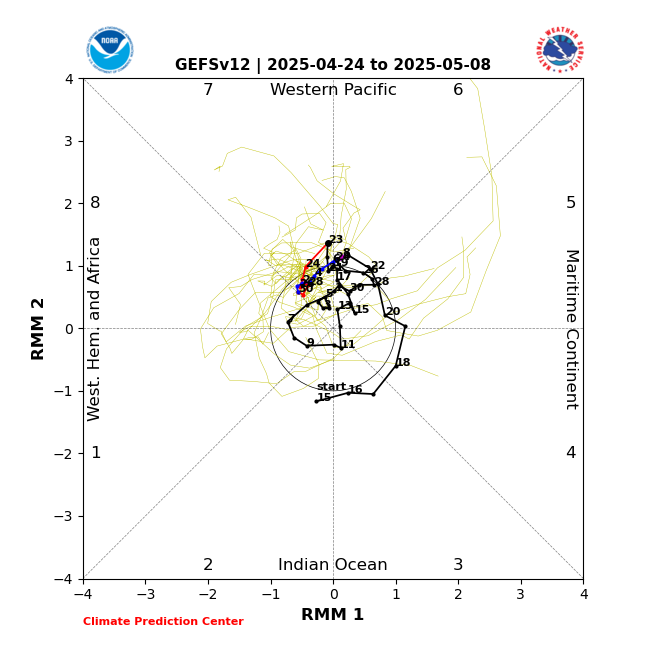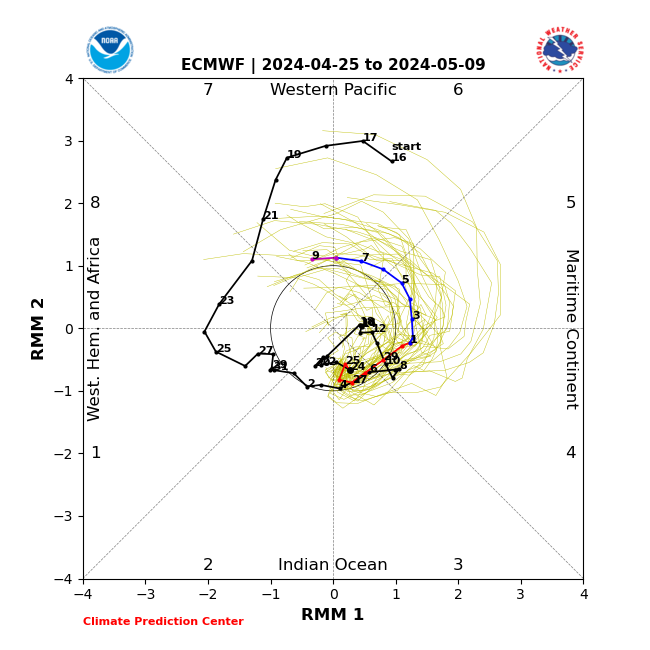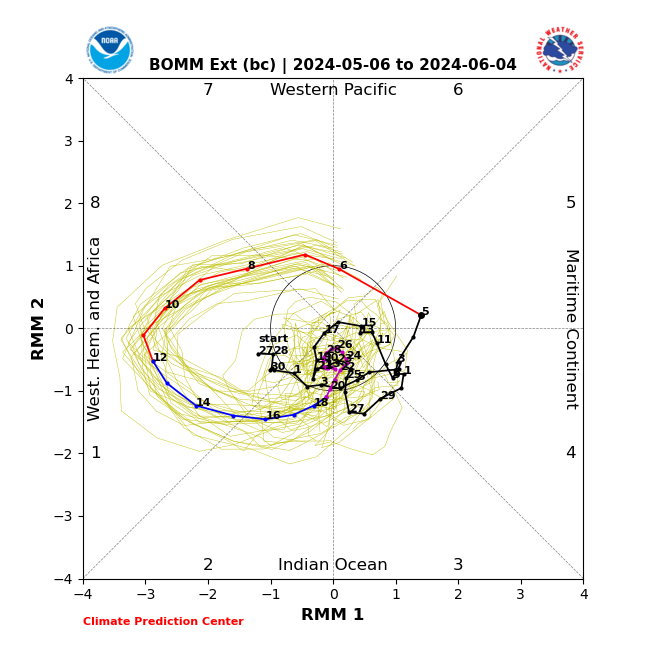Ubuntwo wrote:zzzh wrote:https://i.imgur.com/V5gGUzG.png Does it? I don't have a PVS frequency anomaly map but the 200mb vorticity should work as well: You can clearly see the enhanced anticyclonic wavebreaking near 30N, which is the opposite of what the 'bottom PVS' figure shows. I wonder if anyone has the link to the paper? I would like to read it.
You’re comparing a single month from the early season to a whole-season average. The graphic aims to establish the predictive power of SST anomalies, not their hindcast potential. The paper is Papin’s dissertation on PVS, it’s not freely available but you may have access through a university. I imagine he would also be more than willing to send a copy if you shoot him a message.
Some excerpts from Papin's PHD dissertation:
3.4.2 NATL MDR SSTs
Another factor proposed to influence PVS activity in the Atlantic basin is changes in yearly SST anomalies in the Atlantic basin MDR, because SST changes modulate convective activity that can erode the southern extent of low-latitude PVSs. For this investigation, the composite PVS frequency anomaly for the lowest eight SST anomalies and highest eight SST anomalies years (corresponding to the bottom and top 20th percentiles) in the NATL basin MDR are plotted in Fig. 3.19, using SST anomaly data from Kaplan et al. (1998) extended to 2015, where the MDR is defined between 10–20o N and 20–80W (see Fig. 3.3), a location where TC development is common in the Atlantic basin (e.g., Gray 1968; Zhang et al. 2017).
In low SST anomaly years, there is a notable increase in PVS frequency relative to climatology with the greatest anomalies (+4–6%) observed along the equatorward flank of the climatological PVS frequency maximum around 25N in the Atlantic basin (Fig. 3.19a). The inverse is true for high SST anomaly years, where a -4–6% anomaly relative to climatology is present in roughly the same location in the Atlantic basin (Fig. 3.19b). A possible explanation for this inverse relationship in SST anomaly relative to PVS frequency could be related to the presumption that higher MDR SST anomalies in the Atlantic basin would promote more deep, moist, convection between 10–20N. The outflow from this convection could, therefore, impinge on PVS activity occurring poleward, and act to destroy upper-tropospheric positive PV anomalies. The opposite would be true for low SST anomaly years, where implied suppressed convective activity may allow PVSs with higher-PV air to penetrate equatorward in the Atlantic basin. When comparing MDR SST anomalies to PVSI, a moderate negative correlation is observed (r = -0.43; Fig. 3.20). A large year-to-year spread exists, however, and two of the three highest PVS activity index years feature MDR SST anomalies that are on the warmer end of the 37-y spectrum. Again, PVSs appear to influenced by more than simply MDR SST variations. One additional SST-based index that is explored in chapter 5 is the AMO, where additional context will be provided since the AMO has also been shown to significantly affect TC activity on low frequency timescales (Klotzbach and Gray 2008).
5.3.2. Spatial pattern of top and bottom ACE and PVS activity years So far we have documented statistical correlations between PVSI and ACE, and how the number of PVSs change in top and bottom ACE years. It is also illuminating, however, to plot correlations between PVS frequency and ACE in a spatial sense (Fig. 5.4). Over most of the NATL basin, a negative correlation exists between PVS frequency and ACE, though this negative correlation increases in magnitude (between -0.3 to -0.6) and is statistically significant mainly equatorward of 30N in the western NATL basin. This area is associated with the most
TC activity as evidenced by the wide swath of climatological ACE between 2–6×104 kt2 spanning the region. The negative correlation in this region signifies that lower ACE is observed as PVS frequency increases over this part of the domain. To further confirm the relationship between PVS frequency and ACE, Fig. 5.5 shows yearly PVS frequency anomalies relative to climatology for bottom and top ACE years. Not surprisingly, bottom ACE years exhibit an expansive area (70–30W) of statistically significant positive PVS frequency anomalies (between +3 to +6%) relative to climatology, mostly equatorward of the climatological PVS occurrence maximum (Fig. 5.4a). One interpretation of this map is that the time-mean TUTT axis in these seasons may be stronger and displaced equatorward closer to the MDR in the NATL basin, which is associated with enhanced VWS equatorward of the TUTT and suppressed moisture along the TUTT axis (Fitzpatrick et al. 1995; Knaff 1997).
In contrast, top ACE years exhibit an expansive area (70–30W) of statistically significant negative PVS frequency anomalies (between -4 to -6%) relative to climatology, primarily equatorward of the climatological PVS occurrence maximum (Fig. 5.4a). In turn, the time-mean TUTT axis in these seasons may be weaker and displaced poleward away from the MDR in the NATL basin, which is associated with reduced VWS downstream of the TUTT axis (Fitzpatrick et al. 1995; Knaff 1997). To confirm the possible changes in environmental VWS and moisture described above, Fig. 5.6 illustrates composite difference plots of bottom ACE years minus top ACE years (see Table 5.2 for years used in each subset). The most prominent feature in Fig. 5.6a is the statistically significant dipole of enhanced westerly VWS between 10–20N across the NATL basin and a corresponding area of reduced VWS differences between 20–30N. This pattern depicts a cyclonic circulation of VWS vector differences, which is associated with the change from positive to negative PVS frequency anomalies between bottom and top ACE years in Fig. 5.5. In addition, this region is also associated with a statistically significant reduction in uppertropospheric thickness (Fig. 5.6b), precipitable water (Fig. 5.6c), and an enhancement of the sea level pressure (Fig. 5.6d) associated with 925-hPa anticyclonic flow differences. These differences in thickness, moisture, and sea level pressure link back to the stronger and larger PVS composites presented in Chapter 4 (Fig. 4.4, 4.7, 4.11, 4.14), which were previously noted to occur in higher frequency in bottom ACE years (Fig. 5.3). A lingering question that remains is if the same spatial patterns of these environmental variables also exists between top minus bottom PVSI years.
Figure 5.7 shows the same four variables described in Fig. 5.6, except for differences between top PVSI years minus bottom PVSI years. Once again, statistically significant enhancement of VWS is observed between 10–20N with an associated reduction in precipitatble water, upper-tropospheric thickness, and enhanced sea level pressure centered around 20N. Note that while the variable differences between high minus low PVSI years are similar to bottom minus top ACE years, the yearly composite subsets are not identical, since only four years are shared between top ACE, bottom PVSI and bottom ACE, top PVSI. Subtle differences do exist in the VWS, thickness, precipitable water, and sea level pressure differences, which all appear to shift further east in the NATL basin versus what is observed in Fig. 5.6. The general pattern remains, however, where cyclonic VWS differences, lower thickness, lower precipitable water, and enhanced sea level pressure around 20N appear to occur in conjunction with increased PVS activity in the NATL basin. Focusing on the region where TC activity is most prevalent, VWS and precipitable water for each year is averaged in a box between 10–30N and 20-90W to see if there are significant changes in this region associated with yearly PVSI.
Figure 5.8 shows a scatter plot of both variables versus PVSI. For VWS (Fig. 5.8a) there is a moderate positive correlation (r = 0.49) where increasing PVSI generally results in an increase in VWS where TCs frequently occur in the NATL basin (Fig. 5.4, ACE climatology in black contours). In contrast, precipitable water in this same domain exhibits a moderate negative correlation (r = -0.43) where increasing PVSI generally results in a decrease in precipitable water where TCs frequently occur in in the NATL basin. The top and bottom ACE years are also depicted as red and blue dots in both plots in Fig. 5.8. These years illustrate that significant variability in VWS and precipitatble water can still occur, even among yearly subsets associated with top and bottom ACE, respectively. Overall, the results presented in this section fall in line with the results presented in Zhang et al. (2017, see Fig. 1.9 in Chapter 1), with a few exceptions. For instance, PVS intensity variations can modify the relationship between PVS activity and TC activity (e.g., Fig. 5.1 c–d). Thus, using a metric such as PVSI provides added value by incorporating size and intensity of PVSs into its overall quantity, and produces the strongest negative correlation (Fig. 5.2), even though its relationship with TC activity is not linear. Higher PVSI years are associated with larger and stronger PVSs, which increase VWS and decrease precipitatble water in low latitudes (Figs. 5.7, 5.8). These negative environmental factors explain why the strongest negative correlation between PVS frequency and ACE occurs between 10–30 N mostly west of 40W (Fig. 5.4). The latter result suggests that different modes and locations of TCG may influence the correlation between PVSs and TCs, which will be explored in section 5.6.
































